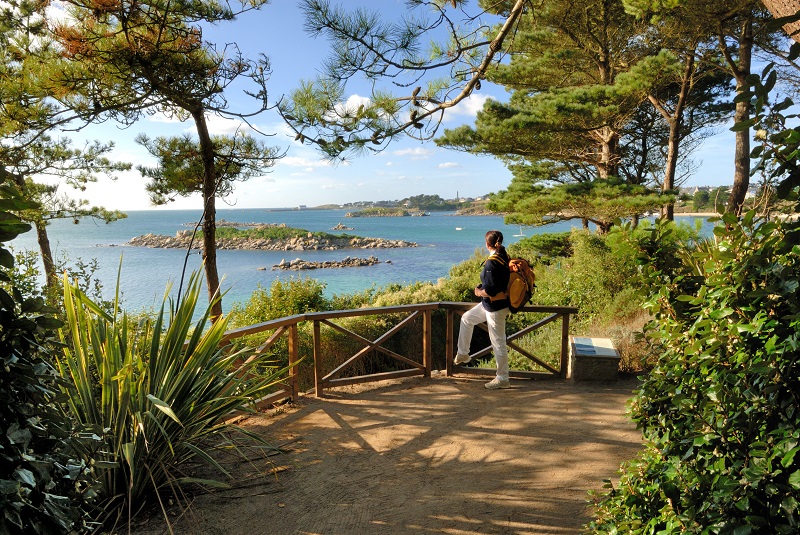At Charme Bretagne, we love beautiful houses and beautiful gardens, it’s no mystery! It is therefore quite natural that as summer approaches, we would like to introduce you to the North of Finistère and its remarkable gardens. Nature lovers, you will love its parks, flower gardens, vegetable gardens and arboretums for a most soothing walk.
What if to start with, we took you to visit two exotic gardens, the Roscoff garden and the Delasselle garden on the island of Batz.
The Bay of Morlaix, towards Roscoff
The Exotic Garden of Roscoff
The Exotic Garden of Roscoff, created in 1986, overlooks the port of this pretty corsair city and offers a panoramic view of the Bay of Morlaix.
3500 species of subtropical or exotic plants occupy the 1.6 hectares, but thanks to its winding paths and mounds covered with plantings, the garden seems even larger and surprises the visitor with its many views.
It has one of the largest collections of southern plants grown in our climates. Let’s go for a stroll near the goldfish pond, find the waterfall and climb the 18-meter rock to admire Roscoff and the magnificent Bay of Morlaix with its dazzling colors and extraordinary scents. In the heart of Roscoff, let’s discover the superb sculpted facades of the corsairs’ houses and meet at the port for a boarding trip to the island of Batz.
Embark for the Ile de Batz, explore the Delaselle Garden
There is another remarkable exotic garden, the Jardin Delaselle, which has more than 2500 species from the five continents. This garden, created in 1897 by a Parisian insurer who fell in love with the island of Batz, is located on the south coast of the island. At that time, there were still no trees and to protect his plants from the wind, Georges Delaselle had large basins dug in the sand.
This garden is a conservatory of the world’s biodiversity, plants from the southern hemisphere, California, the Mediterranean basin etc… Its exuberance is striking and contrasts sharply with the rather harsh and maritime landscapes of the island.
Let’s take the opportunity to go around the island which is only 3.5 km by 1.2 km, its beaches to the north are splendid.
Brest and its Garden of the National Botanical Conservatory at Stang Alar
On the way, visit the Château de Kerjean
On the way to Brest, let’s stop at the Château de Kerjean, an unmissable jewel of the Breton Renaissance and admire, as soon as you enter the park, its majestic dovecote so well preserved. Louis XIII said of it: “The said house and castle of Kerjean is of such a beautiful and magnificent structure that it would be worthy of our collection and stay if our business called us there”. The visit of the castle is very interesting and informs us, with the help of very well done multimedia, about life in the sixteenth century, so rich in Brittany.
Don’t miss the Parish Enclosures of Saint Thégonnec
And on the road, we will enjoy discovering the Parish Enclosures, unique in the world and contemporary with the Château de Kerjean, testimonies of the richness and power of this region thanks to the cultivation and weaving of flax: Saint-Thégonnec the flamboyant, Guimiliau and its Calvary, Bodilis and its sculpted sand pits and La Martyre the first built in the fourteenth century is one of the most moving under its golden lichens.
Let’s now go to Brest and its Garden of the National Botanical Conservatory at the Stang Alar, an exceptional place where endangered plants and ornamental plants rub shoulders in former quarries. Its many ponds and cliffs make it an enchanting place appreciated by young and old alike.
In greenhouses, the vegetation of tropical humid mountains, subtropical oceanic islands, dry tropical areas and also tropical rainforests, offer themselves to our contemplation.
Outside, the plants are grouped by major regions, Armorica, the Mediterranean, Asia, Australia and finally the United States. Further afield, the valley offers extraordinary landscapes and a privileged habitat for wildlife.
Near the Castle which overlooks the bay of Brest and its ports, we can admire the Explorers’ Garden. This garden was dedicated to maritime explorers such as Bougainville or La Billadière, who set off from Brest and brought back plants that were unknown at the time. Don’t miss the view of the castle and the famous and impressive harbour of Brest from the footbridge.
A small detour to the Abbey of Daoulas and its medicinal garden
This 12th century abbey church has a Roman cloister unique in Brittany, a 16th century oratory, as well as exceptional medieval gardens that make it a place not to be missed in North Finistère.
The monks of the order of Saint Augustine have governed the abbey of Daoulas since the twelfth century. The abbey retains magnificent testimonies of its splendour: a medicinal garden designed on the models of the Middle Ages is tiered in two terraces overlooking the abbey church and the cloister. It has 250 species representative of the traditional pharmacopoeias of the five continents. The abbey offers temporary exhibitions on distant cultures through rare objects.
Cross the Monts d’Arrée and stop at the arboretum of the trees of the World
From Daoulas to Le Huelgoat, let’s cross the Monts d’Arrée with its incredible and mythical landscapes that offer the imagination an inexhaustible playground. Beware of korrigans and other leprechauns!
The arboretum of the Trees of the World in Huelgoat, was created 40 years ago by a passionate about the plant world and director of the retirement home; This allowed the residents to grow their vegetables and continue a small activity. The site was bought in 2011 and has since been open to the public: 22 hectares, 3600 species of trees from the five continents. Let’s discover the Australian bush, the Himalayan valley, the Chilean flora not to mention “our” rhododendrons from Asia Minor.
End the trip in Morlaix in the gardens of the Relec Abbey
On the way to Morlaix, let’s stop at the Relec Abbey, the only Cistercian abbey in Brittany. In its heyday, the park was an extremely prosperous agricultural estate. The Cistercian monks had designed a rather bare and sober ensemble, but nature has reclaimed its rights. Here, plant and animal biodiversity is expressed around a pond, water being an essential element in the harmony of this abbey.
We now invite you to visit Morlaix, for its astonishing urban planning adapted to its hills, its unique houses in Pondalez, its tobacco factory, its port and its impressive viaduct. And all this, at the water’s edge.
And of course during your stays, we will make you discover the wonderful gardens of the houses of the Club Charme Bretagne.
Have a good walk!




